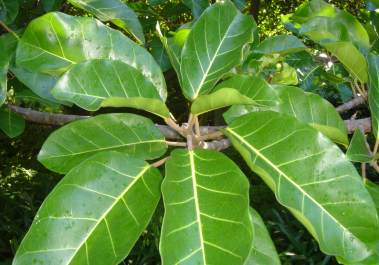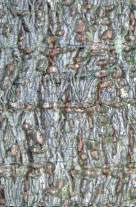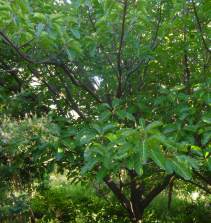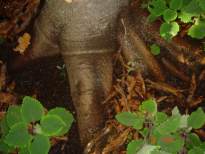Ficus lutea
Ficus lutea Vahl
Family: Moraceae
Common names: giant-leaved fig (Eng.); reuseblaarvy (Afr.); umvubu, omkhulu (Zulu); umthombe, uluzi (Xhosa)
SA Tree No: 61
Introduction
The giant-leaved fig is a magnificent member of the renowned fig family. Like so many of its close relatives, it offers much of ecological and ornamental value. To behold a mature specimen displaying its full spread and large, sculptured buttress roots is an impressive sight and one not easily forgotten.

Description
Description
Ficus lutea is a large, briefly-deciduous tree, capable of growing to 25 m in height. Its large, spreading crown can span 30 to 45 m in width. This spreading habit coupled with an often short and buttressed trunk can help in revealing the tree's identity from a distance. Under forest conditions, however, it tends towards a taller growth habit with a somewhat narrower spread. The species also has the ability to become a strangler and is often encountered assuming this habit.

The bark is relatively smooth-textured and dark grey to brown in colour. Branches may be finely hairy when young, becoming smooth with age. The lovely smooth, glossy leaves are very large in size, as the common name would suggest, and are quite distinctive, ranging from 130 to 430 mm in length and up to 200 mm in width. They are held towards the ends of the branches, are ovate to elliptic or obovate, and exhibit clear yellow veining. The attractive bronze stipules effectively sheath the terminal buds. The leaf margins are entire and the stout leaf stalks measure from 25 to 150 mm in length.

The syconia ('fruits'), borne most often between June and October, are crowded towards the ends of the branchlets in the leaf axils or below the leaves. They measure 15 to 30 mm in diameter, are sessile (stalkless) and are densely hairy to smooth. Although exhibiting many distinctive characters, Ficus lutea can superficially resemble F. trichopoda (swamp fig) with which there is some distribution overlap. The latter is distinguished in having 7 to 11 pairs of lateral veins in the leaves as opposed to the 6 to 8 evident in F. lutea, and stalked fruit, the fruit of F. lutea being sessile (Coates Palgrave 2002).
Distribution and habitat
Distribution description
The giant-leaved fig is a widely distributed species. It occurs naturally in South Africa, Mozambique and Zimbabwe, into tropical and west Africa, as well as in Madagascar, the Comores and Seychelles (Burrows & Burrows 2003). It is a commonly cultivated species and has become naturalized in areas previously outside its distribution range. The habitats in which it occurs are varied, ranging from coastal and riverine forest to evergreen forest and woodland. The species is seen to occur from sea level to 1 000 m and, in some areas up to 1 800 m above sea level (Burrows & Burrows 2003), representing a notable altitudinal range. It tends to thrive in the warm, moist and frost-free areas within its range, and under such conditions can be a very fast grower indeed (Palmer & Pitman 1972).
Derivation of name and historical aspects
History
The genus Ficus is found throughout the tropical and subtropical regions of the world and is comprised of between 750 and 800 recorded species. The genus is a taxonomically difficult one resulting in some degree of uncertainty regarding a number of species. A consequence of this has been much lumping and splitting of species over the years, yielding a long line of related name changes and synonyms. The greatest concentration of figs is found in SE Asia, numbering approximately 500 species, with roughly 100 species occurring on the African continent. The southern African region is home to 48 of these. The genus belongs to the relatively large Moraceae family, comprising a total of 37 genera and roughly 1 100 species. Features characteristic of the family include the presence of a latex (often milky), stipules serving as apical bud sheaths, unisexual flowers and simple leaves. Notable members of the Moraceae include the well-known mulberry (Morus alba) and the common fig (Ficus carica) , both having been in cultivation since early times.
It is from the Latin term ficus, referring both to the fig tree and the fig, that the generic name Ficus directly stems (Burrows & Burrows 2003). With regard to the specific epithet, it is not entirely clear whether lutea refers to the yellow venation of the leaves or to the yellow hues the leaves acquire in the autumn to winter months prior to dropping (Burrows & Burrows 2003).
Ecology
Ecology

From an ecological perspective, the giant-leaved fig is both fascinating and remarkable. Fig trees in general have a well-founded reputation for being virtual wildlife magnets and this species proudly upholds this reputation. A wide variety of frugivorous (fruit-eating) birds are attracted by the promise of a good meal in the form of the abundant fleshy figs produced by the tree. Numerous insectivorous bird species join the feast, feeding on the rich insect life that is drawn to the figs. In addition, the figs are relished by a range of mammals that include bats, duikers and Vervet and Samango monkeys, as well as baboons in areas where they coexist with F. lutea (Nichols 2004. pers. comm.). The masses of fallen figs also support much decomposition-related activity. The seed of the tree is effectively dispersed by many of these animals. Seed may be carried considerable distances by birds, often being deposited in the forks of trees and in the cracks of buildings and the like and here the hemi-epiphytic (and often 'strangling') nature of this species is evident.
Pollination represents an amazing and intriguing aspect of fig life. Figs rely entirely on specific fig wasps for effecting pollination (the pollinator species of F. lutea being Allotriozoon heterandromorphum), these wasps, in turn, being totally reliant on the figs for meeting their reproductive requirements, a relationship referred to as obligate mutualism.
Uses
Use
The giant-leaved fig is well known for its horticultural value and is cultivated in various regions in Africa (Burrows & Burrows 2003). In the wetter, warm eastern parts of South Africa, it is a popular street tree and is a common feature in parks and other urban open spaces. Its use in horticulture has attached to it some economic value also, as is evident in the nursery trade. The bark has been used traditionally in the production of twine and the plant sap (latex) is used for bird lime (Pooley 1993). The use of the bark in the production of bark cloth has been recorded in Mozambique, this cloth being a commodity in the region (Burrows & Burrows 2003). In West Africa the fruits are known to be consumed by people, and in Angola the wood of the tree is used for the making of bowls (Burrows & Burrows 2003).
Growing Ficus lutea
Grow
This species can be grown successfully from both seed and truncheons. Ripe figs should be opened and allowed to dry for a day or so. Alternatively, they can be stored for a few months in a cool, dry and dark spot and sown when conditions are favourable, the recommended time being spring. Nichols (2004 pers. comm.) recommends a growing medium consisting of equal parts washed river sand and vermiculite. Spread the seeds over the growing medium in seed trays and cover lightly with this same medium. Place the trays in a warm, well-aired and brightly-lit spot, ensuring the medium is kept moist. Germination times may vary from 10 days to one month and after around one week of growth the seedlings are best moved into a sunny position. Once the young plants have gained some strength and composure, transplant into bags in a rich, well-drained soil mix.
The use of truncheons is popular too and, being a vegetative (asexual) method of propagation, yields clones of the mother plant. Truncheons, with a diameter of 70-80 mm, can be inserted by a third of their length into a sand and compost mix, good drainage being a key factor.

The ability of this generally fast-growing species to withstand winds and salt spray make it well suited to the warm, subtropical coastal region. It is also suited for use as an indoor plant. In the garden situation it makes a fine spreading shade tree and helps greatly in supporting wildlife in the urban setting. (Due to its aggressive root system, however, avoid close proximity to foundations, piping, paving or other structures and utilities).
Plant in a large hole, add a generous amount of compost and water regularly until well established. Whether planted for its wonderful aesthetic, functional or ecological value, this beautiful and majestic fig is sure to add a special kind of magic.
References
- Burrows, J. & Burrows, S. 2003. Figs of southern and south-central Africa. Umdaus Press, Hatfield.
- Coates Palgrave, M. 2002. Keith Coates Palgrave Trees of southern Africa, edn 3. Struik, Cape Town.
- Palmer, E. & Pitman, N. 1972. Trees of southern Africa, 3 vols. Balkema, Cape Town.
- Pooley, E. 1993. The complete field guide to trees of Natal, Zululand and Transkei. Natal Flora Publications Trust, Durban.
- Van Wyk, B. & Van Wyk, P. 1997. Field guide to trees of southern Africa. Struik, Cape Town.
Credits
Jan-Hakon Burring
Kirstenbosch National Botanical Garden
March 2004
Plant Attributes:
Plant Type: Tree
SA Distribution: KwaZulu-Natal
Soil type:
Flowering season:
PH:
Flower colour:
Aspect: Full Sun
Gardening skill: Easy
Special Features:
Horticultural zones








Rate this article
Article well written and informative
Rate this plant
Is this an interesting plant?
Login to add your Comment
Back to topNot registered yet? Click here to register.